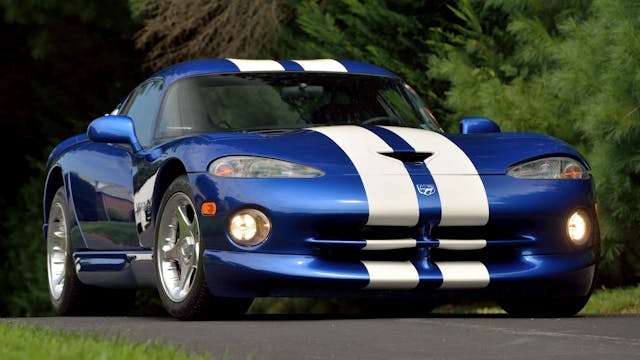The 10 coolest cars with NACA ducts
At the beginning of World War I, just 11 years after the Wright brothers’ first flight, the United States was lagging behind Europe in aviation technology. In an effort to catch up, Congress formed the National Advisory Committee for Aeronautics (NACA) on March 3, 1915. The organization, which would become the National Aeronautics and Space Administration (NASA) in 1958, reported directly to the president and began to develop wind tunnels to study streamlining and aerodynamics. The research rapidly increased the range and speed of American aircraft.
In the 1930s and 1940s NACA developed an airfoil design for wings and propellers that can be found on many important WWII aircraft including the P-51 Mustang. NACA contributed greatly to the first supersonic flight in 1947, achieved by Chuck Yeager at the stick of the X-1 experimental airplane, and thereafter turned its attention to missile technology and manned space flight.
Many of the organization’s aerodynamic achievements began to influence the design of automobiles, and the NACA ducts appeared on cars in the mid-1950s.
“In 1951 the original NACA report on it was declassified, and the design of the duct became public information, available for use by anyone,” wrote Motor Sport magazine in 2000. “Racing cars were an obvious application, but it wasn’t until 1956 and the emergence of Frank Costin’s redesigned Vanwall that someone had the nous to exploit it.”
That same year, small recessed scoops also appeared on the quarter panels of Ford’s Continental Mark II. They’re not exactly NACA ducts, but they’re close.
Developed in the agency’s wind tunnels, the low-drag air inlet submerged into the bodywork with curved sides and a blunt, squared-off end is still commonly found on race cars and high-performance production cars today. The NACA duct has become an iconic statement of speed.
Presented in chronological order, here are our picks for the 10 coolest high-performance street cars with NACA ducts.
1969–70 Ford Mustang Shelby GT350/GT500

Carroll Shelby didn’t have much to do with the Shelby Mustang by 1969; however, the car’s distinctive fiberglass hood with three NACA ducts assures both the GT350 and the GT500’s places on this list. The center scoop feeds the carburetor, while the two on the sides help draw hot air out of the engine compartment. The hot air then exits through two open vents closer to the cowl.
The hood design remained the same over the two model years, though the 1970 cars were actually leftover 1969 models and received black hood stripes for visual distinction.
1973 Pontiac GTO

This is the only muscle car from General Motors ever to wear NACA ducts. Two appeared in the center of its hood—and they were fakes. They did not feed the carburetor as originally intended but were instead blocked off by the factory. Allegedly, Pontiac did offer the rest of the prototyped induction system through dealers and about 10 cars with functional scoops were built. One is said to exist today.
Regardless, the muscle-car craze was quickly winding down by 1973, and the redesigned Pontiac GTO went over with a thud. The body style lasted just one year and Pontiac only sold just 4806, making it the worst-selling GTO of all time.
1974–90 Lamborghini Countach

Officially, we haven’t taken any measurements, but the award for the largest NACA ducts has to go to the Lamborghini Countach, which first appeared at the 1971 Geneva Auto Show and reached production three years later.
The mid-engine supercar features a single and sizable NACA duct on each side, beginning on each door and covering most of the quarter panels, feeding its massive radiators to keep its big V-12 engine cool. Production lasted until 1990 with nearly 2000 produced. Its successors, the Diablo, the Murciélago, and the Aventador, which just finished an 11-year production run, do not feature NACA ducts.
1980–86 Renault R5 Turbo

A homologation special for Group 4 rally competition, this little Renault is basically a Le Car with radically flared hips, rear-wheel drive, and a 158-hp, turbocharged 1.4-liter four-cylinder engine mounted in place of its back seat. About 5000 were built over six years. Two iterations, the Turbo 1 and the Turbo 2, each have a single, small NACA duct atop the left rear quarter panel.
The R5 Turbo was styled by Marcello Gandini at Bertone, who designed the Countach and penned many other machines featuring NACA ducts, including the Alfa Romeo Montreal and the Lamborghini Espada.
1987–96 Ruf Yellowbird

In 1987, Road & Track declared the Ruf CTR the world’s fastest production street car. It received its nickname “Yellowbird” during testing that year when it achieved a terminal velocity of 211 mph and accelerated to 60 mph in 3.6 seconds. It was powered by a twin-turbo, 3.4-liter flat six said to make 463 hp. The car cost $223,000. According to Ruf, 29 examples were built and 20 to 30 more were created from customer 911s.
If you haven’t seen the footage of this car drifting the Nürburgring, check it out on YouTube immediately. Look for its two large NACA ducts, one atop each rear wheelwell flare.
1987 Callaway Corvette

For many Gen Xers, the first car they remember with NACA ducts is the 1987 twin-turbo Callaway Corvette. Three years before the DOHC ZR-1, the most powerful Corvette was created with option code RPO B2K. It sent your new Corvette to Callaway Engineering in Connecticut, where its 5.7-liter V-8 was pumped up from with a pair of turbochargers and intercoolers.
Even sweeter were the two NACA ducts Callaway carved into Corvette’s hood. Sadly, however, they would last only one year. According to Callaway, 445 Corvettes were ordered with the RPO B2K option over the four-year run, so only 123 coupes and 65 convertibles featured the NACA duct hood.
1987–92 Ferrari F40

This was the last Ferrari personally signed off by Enzo himself. Built to commemorate the company’s 40th birthday, the successor to the 288 GTO featured a mid-mounted, twin-turbo 2.9-liter V-8 and two small NACA ducts in its front decklid.
It was the quickest, fastest, most expensive, and most powerful Ferrari of all time, with over 470 hp and a body made of aluminum, carbon fiber, and Kevlar. To save weight, the interior was race-car-raw, without door handles, glovebox, carpet, or sound system. The F40 was a stark contrast to its rival at the time, the all-wheel-drive Porsche 959. Just 1311 F40s were built, with a top speed just shy of 200 mph.
1996–2002/2013–17 Dodge Viper

This one needs a little more explanation. The original Dodge Viper, which went on sale in 1992, did not have a NACA duct in its hood feeding fresh air to its V-10 engine. In 1996, however, Dodge gave the sports car a bit of a facelift and introduced a coupe version called the Viper GTS.
The GTS was the first Viper with the large NACA duct in its hood, but Viper roadsters remained scoopless. An all-new Viper coupe and convertible arrived in 2003. Although a scoop remained in the hood of each style, it was not a NACA duct. This arrangement remained the lay of Viper land through 2010. The model left us for a little while, finally returning for a brief four years in 2013 as a coupe only … happily, with an aerodynamic NACA duct.
2008–15 Mitsubishi Evo X

This is the only four-door sedan on this list—the 10th and final generation of the Mitsubishi Evolution, a turbocharged and all-wheel-drive rally car inspired by the rival of the Subaru WRX STI. Known for its flared flanks and oversized rear spoiler, the last of the Evos also wore a single NACA duct in its hood. Although it wasn’t functional on the street-going model, the duct was put into use on Evos in rally competition. These cars were powered by a turbocharged, 16-valve 2.0-liter four-cylinder that made 291 hp and 303, in the Final Edition.
2009–2020 Nissan GT-R

NACA ducts did not appear on the R32, R33, or R34 versions of Nissan’s Skyline GT-R. However, they’ve been an important part of the aerodynamics and performance of the R35 GT-R, which was launched in 2009 and remains in production 14 years later. There have always been two on the supercar’s hood, and on 2019’s 600 hp GT-R NISMO, they were incorporated into the composite structure of the panel. They’ve never directed air into its boosted 3.8-liter V-6; instead, they duct cool outside air onto the engine’s twin turbochargers for cooling.
***
Check out the Hagerty Media homepage so you don’t miss a single story, or better yet, bookmark it. To get our best stories delivered right to your inbox, subscribe to our newsletters.



The Pontiac NASA (as they called it) hood scoops were standard on the 1973 GTO, but were available as an option on most 1973-1975 Pontiac intermediates (A-bodies). They were non-functional because the system could not pass Federal drive-by noise standards per John Sawruk, Pontiac historian. Several Pontiac engineering and pilot cars had the functional version of the system. Pontiac briefly offered some of the parts through the dealer parts system in the fall of 1972. It is unknown how many complete systems were purchased. The special molded plastic air cleaner lid with the solenoid assembly was almost impossible to obtain. About three complete systems exist today making it Pontiac’s rarest Ram Air system.
It is incorrect that the body style only lasted one year. All GM 73-77 A-body intermediate models were based on the same platform.
“It is incorrect that the body style only lasted one year. All GM 73-77 A-body intermediate models were based on the same platform.”
Actually it’s not. The quote in the story was:
“Regardless, the muscle-car craze was quickly winding down by 1973, and the redesigned Pontiac GTO went over with a thud. The body style lasted just one year and Pontiac only sold just 4806, making it the worst-selling GTO of all time.”
He means that the GTO only lasted one year on the new 1973-77 Colonnade A-body platform. The 1972 GTO was the former 1968-72 A-body platform and the 1974 GTO was moved to the X-body platform (Nova/Ventura) and then killed off.
Anyone else get irritated when people refer to these as NASA ducts? Like nails on a chalkboard.
AMEN!!!!!
What grates on my ears is when people pronounce NACA with a hard c (as if it were “NAKA”). Way back when I was studying aeronautical engineering, it was pronounced with a soft c (like “NASA”).
Whatever the opinion is about how the scoops on a 71 Mustang hood are called, they are functional and I have measured up to a 10 degree drop in inlet temperature when open. That said, I did not measure a change in manifold pressure between open and closed.
It would have been nice to put a few sentences in the introduction about how these work, but for folks so interested, here is the NACA report:
https://ntrs.nasa.gov/api/citations/20050061115/downloads/20050061115.pdf
NACA ducts were never meant to be high ram-pressure inlets, but rather, to be low-drag inlets with mild pressure recovery. In many cases on aircraft, this was sufficient to feed internal systems and low-flow / low-pressure systems. There are still many situations on aircraft where more intrusive inlets are needed to produce the flow rates and high pressure recovery levels for things like engines, etc.
When you consider the lower speed range of cars, the NACA ducts really had limited application and would have to be carefully placed on a vehicle to function correctly. That was not always done. But properly placed, a NACA duct can intake air with minimal drag, and provide a mild amount of pressure recovery (rise). Because ground vehicles are traveling subsonic and downstream pressure drives flow, the real action of a NACA duct happens upstream where its mild pressure recovery creates suction, drawing air in. Placed properly, this makes for a very effective intake.
Over the years, I have run into several sloppy applications of NACA ducts on vehicles where the flow was extremely poor or even going backwards! I chalked that up to designers not understanding how they work, or putting them in locations of low pressure on the vehicle where the overall pressure differential was not favorable. Step 1 in designing any sort of intake on a vehicle or aircraft is to understand where high pressure regions lie on the clean/watertight outer mold line (OML). That’s where you want to intake air because it already has a tendency to flow where you direct it. And if you can then route flow to exit into to a low pressure region elsewhere on the OML, guess what, you will have reduced drag, or at a minimum, not increased drag. These are the fundamentals designers need to understand before they go blindly sticking NACA ducts on the vehicle. It can’t just be a styling exercise.
Thank you for commenting, very interesting post !!
Thanks for posting that link. I actually searched for that report and put copy of it in my files when I was working, but lost access to it when I retired. Now I don’t have to search for it again!
You missed one of my favs…the Porsche 924 Turbo and GTR!
https://supercarnostalgia.com/blog/porsche-924-turbo
No Porsche 924 Turbo? But you’ll put the crappy 73 GTO with fake ducts?
Can’t believe the Ferrari 512 BBi was left out and so many fake or questionable “vents” were included.
If memory serves, the Ford GT40 was NACA duct equipped. Am sure we’d all agree that model definitely isn’t as cool as a 1973 Pontiac though. 😉